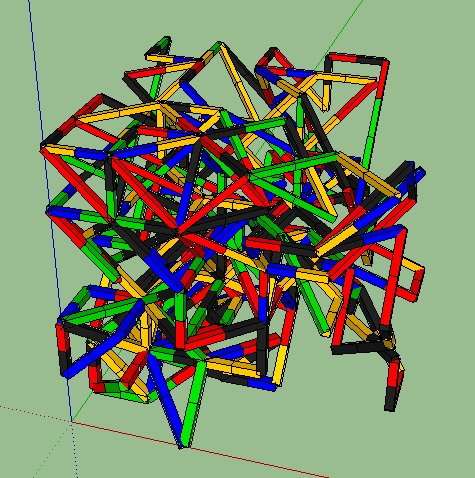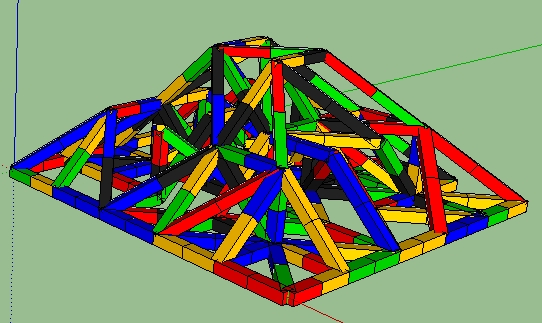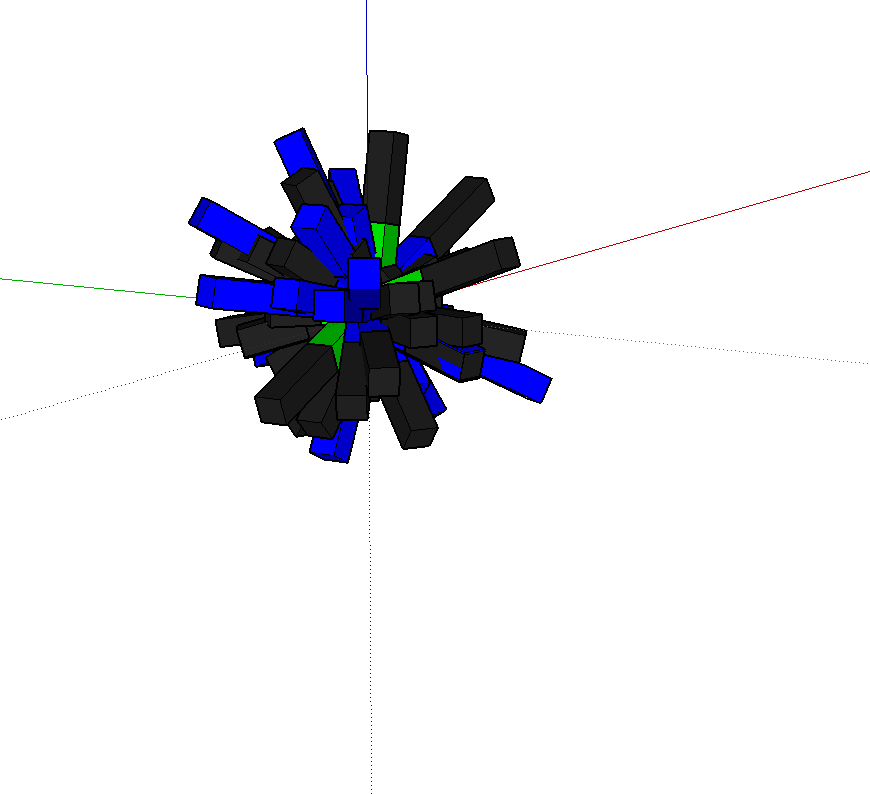Scripting help. Where to start.....
-
Great, thank you for all of your help! I'm really sorry to keep asking you to push this further! I have two more questions.
-
Currently the script is locating each block at a random point within the predefined cube. Can this cube be removed so that the structure is free to grow in any direction ( on second thoughts maybe removing the ability to grow in the -z plane direction?
-
If this process was replicated in the physical word we would have to build from the bottom, securing the structure as we go. If we were to build it, the construction process would be similar to that of a growing tree (for every incremental increase in height there is an increase in the diameter), this helps the structure to retain its integrity. Could this process be replicated? So that the script builds from the bottom -up?
As always thanks again for your help, I really appreciate it!
-
-
@o0rico0o said:
Great, thank you for all of your help! I'm really sorry to keep asking you to push this further! I have two more questions.
-
Currently the script is locating each block at a random point within the predefined cube. Can this cube be removed so that the structure is free to grow in any direction ( on second thoughts maybe removing the ability to grow in the -z plane direction?
-
If this process was replicated in the physical word we would have to build from the bottom, securing the structure as we go. If we were to build it, the construction process would be similar to that of a growing tree (for every incremental increase in height there is an increase in the diameter), this helps the structure to retain its integrity. Could this process be replicated? So that the script builds from the bottom -up?
As always thanks again for your help, I really appreciate it!
-
I would assume so but probably produce some very weird results. Not sure what "-z plane direction" is.
-
Not sure why the order of creation would effect the construction. Varying the "diameter" of the pieces from level to level would be easy enough to do.
-
-
-
I'm all about the weird results! when I said '-z direction' I was referring to nothing below the ground plane.
-
I was thinking in terms of varying the diameter of the overall structure, to create an overall form that is similar to that of a truncated square pyramid.
-
my original image also allows for T connections. how easy would it be to integrate this into the script?
-
-
@o0rico0o said:
- I'm all about the weird results! when I said '-z direction' I was referring to nothing below the ground plane.
This code creates a path which can get a little weird. Plus it varies the "diameter" relative to the height.
mod = Sketchup.active_model > ent = mod.active_entities > sel = mod.selection > # create a 3d node network > nodes = []; nhsh = {} > for z in 0..5 > for y in 0..5 > for x in 0..5 > nodes << Geom;;Point3d.new(x.to_s.to_l,y.to_s.to_l,z.to_s.to_l) > nhsh[nodes.last]=0 > end > end > end > #random connected path > begin > node = nodes[rand(nodes.length)];#pick starting node > end until node.z==0 > mps = []; loops = 0; > loop do > try = 0;dist=0 > begin > near = nodes[rand(nodes.length)] > try += 1 > unless near==node > dist = node.distance(near) > mp = Geom;;Point3d.linear_combination(0.5,node,0.5,near) > unless (dist > '1.75'.to_l || mps.include?(mp)) > mps << mp > break > end > end > end until try==nodes.length > if try < nodes.length > cdn = ['Black-Black','Blue-Blue','Blue-Black','Green-Green','Green-Blue','Green-Black','Yellow-Yellow','Yellow-Green','Yellow-Blue','Yellow-Black','Red-Red','Red-Yellow','Red-Green','Red-Blue','Red-Black'] > cd = mod.definitions[cdn[rand(cdn.length)]] > ci = ent.add_instance(cd,Geom;;Transformation.new()) > xys = '1'.to_l * (1.0 + (3.0-node.z)/10.0)#vary diameter relative to height > tr = Geom;;Transformation.scaling(xys,xys,dist) > ci.transform! tr > vector = node.vector_to(near).normalize > xa,ya,za = vector.axes > tr = Geom;;Transformation.axes(node,xa,ya,za) > ci.transform! tr > Sketchup.active_model.active_view.refresh > else > puts "trys exceeded nodes"; return > end > node = near > loops += 1; break if loops > 250 > Sketchup.set_status_text "Segment #{loops}" > end >
- I was thinking in terms of varying the diameter of the overall structure, to create an overall form that is similar to that of a truncated square pyramid.
This code variation produces something like a pyramid.
for z in 0..3 > for y in z..5-z > for x in z..5-z >
- my original image also allows for T connections. how easy would it be to integrate this into the script?
Nothing I do prevents "T" connections.
-
Brilliant this is perfect! The only issue that I'm having is that the model is too small, How can I change the script to make the individual elements 50x50x800mm? Thanks again!
-
@o0rico0o said:
Brilliant this is perfect! The only issue that I'm having is that the model is too small, How can I change the script to make the individual elements 50x50x800mm? Thanks again!
Unless you eliminate all diagonal elements, they can't all be 800mm.
-
No thats fine, I don't mind variation, I was just wondering how to adapt the script to work at a larger scale. At the moment the elements are drawn at 0.2x0.2x3mm
-
@o0rico0o said:
No thats fine, I don't mind variation, I was just wondering how to adapt the script to work at a larger scale. At the moment the elements are drawn at 0.2x0.2x3mm
This variation produces 50X50X800mm elements.
mod = Sketchup.active_model ent = mod.active_entities sel = mod.selection # create a 3d node network nodes = []; nhsh = {} for z in 0..5 zz = (z*800.mm).to_s.to_l for y in 0..5 yy = (y*800.mm).to_s.to_l for x in 0..5 xx = (x*800.mm).to_s.to_l nodes << Geom;;Point3d.new(xx,yy,zz) nhsh[nodes.last]=0 end end end #random connected path begin node = nodes[rand(nodes.length)];#pick starting node end until node.z==0 mps = []; loops = 0; loop do try = 0;dist=0 begin near = nodes[rand(nodes.length)] try += 1 unless near==node dist = node.distance(near) mp = Geom;;Point3d.linear_combination(0.5,node,0.5,near) unless (dist > 1400.mm || mps.include?(mp)) mps << mp break end end end until try==nodes.length if try < nodes.length cdn = ['Black-Black','Blue-Blue','Blue-Black','Green-Green','Green-Blue','Green-Black','Yellow-Yellow','Yellow-Green','Yellow-Blue','Yellow-Black','Red-Red','Red-Yellow','Red-Green','Red-Blue','Red-Black'] cd = mod.definitions[cdn[rand(cdn.length)]] ci = ent.add_instance(cd,Geom;;Transformation.new()) # xys = '1'.to_l * (1.0 + (3.0-node.z)/10.0) tr = Geom;;Transformation.scaling(15.7480315,15.7480315,dist) ci.transform! tr vector = node.vector_to(near).normalize xa,ya,za = vector.axes tr = Geom;;Transformation.axes(node,xa,ya,za) ci.transform! tr Sketchup.active_model.active_view.refresh else puts "trys exceeded nodes. dist=#{dist}"; #return end node = near loops += 1; break if loops > 250 Sketchup.set_status_text "Segment #{loops}" end -
Hmmmm, did it work for you? Im getting this?

-
@o0rico0o said:
Hmmmm, did it work for you? Im getting this?
[attachment=0:12yqg6cm]<!-- ia0 -->Screen Shot 2014-12-01 at 17.17.10.png<!-- ia0 -->[/attachment:12yqg6cm]
Yes it works for me. Are you using the model I sent you? Have you created your own components? Have you changed the model units from inches?
-
Ahhh, yes, I changed It from inches to mm. That could be the issue, Thanks!
Advertisement







